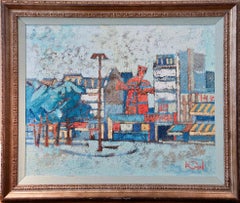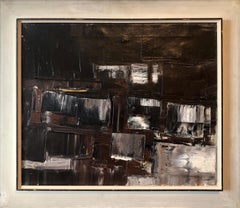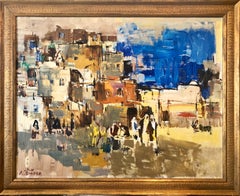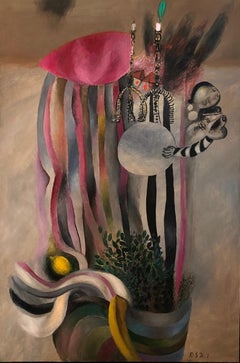Want more images or videos?
Request additional images or videos from the seller
1 of 8
Abram KrolPolish French Mid Century Modern Abstract Venice Gondola Canal Scene
$2,600List Price
About the Item
- Creator:Abram Krol (1919 - 2001, Polish)
- Dimensions:Height: 20 in (50.8 cm)Width: 24.25 in (61.6 cm)
- Medium:
- Movement & Style:
- Period:
- Condition:
- Gallery Location:Surfside, FL
- Reference Number:1stDibs: LU3822524421
Abram Krol
Abram (Abraham) Krol (Polish, 1919-2001) was a School of Paris artist known for his painting and fine prints depicting still lifes, landscapes, portraits, and city scenes, in a style that balanced juxtaposition of forms and objects found in everyday life, reminiscent of Cubism. Originally from Poland, Kroll moved to France in 1938 to study civil engineering at the University of Caen. At the outbreak of WWII, he joined the Foreign Legion. Upon demobilization, he worked in Avignon as a mechanic in a garage also while taking courses in sculpture at the city's School of Fine Arts. Although Jewish, he was able to survive the war by using false identities. In 1944, he settled in Paris and took up the study of engraving under fellow ex-patriot and master print maker Joseph Hecht. Hecht at that time was recognized internationally for his groundbreaking techniques in intaglio. He would go on to teach and pass on these innovations to many important artists of the day, including British Surrelist painter and printmaker, Stanley William Hayter. In 1946, Krol held his first major exhibition at the renown Katia Granoff Gallery, in Paris. Krol also designed and engraved medals for the Paris mint, painted murals for various schools throughout France, created tapestries, and produced over 200 works in enamel. His work is held in major private and public collections throughout the world, including Bibliotheque Nationale in Paris; the Victoria and Albert Museum in London; the British Museum; Houghton Library, Harvard; Bodleian Library, Oxford, and the Palace of the legion of Honor in San Francisco, California.
About the Seller
4.9
Platinum Seller
Premium sellers with a 4.7+ rating and 24-hour response times
Established in 1995
1stDibs seller since 2014
1,824 sales on 1stDibs
Typical response time: 1 hour
Authenticity Guarantee
In the unlikely event there’s an issue with an item’s authenticity, contact us within 1 year for a full refund. DetailsMoney-Back Guarantee
If your item is not as described, is damaged in transit, or does not arrive, contact us within 7 days for a full refund. Details24-Hour Cancellation
You have a 24-hour grace period in which to reconsider your purchase, with no questions asked.Vetted Professional Sellers
Our world-class sellers must adhere to strict standards for service and quality, maintaining the integrity of our listings.Price-Match Guarantee
If you find that a seller listed the same item for a lower price elsewhere, we’ll match it.Trusted Global Delivery
Our best-in-class carrier network provides specialized shipping options worldwide, including custom delivery.You May Also Like
Charles Levier Midcentury Oil Painting of French Canal Scene, Signed c. 1955
By Charles Levier
Located in Miami, FL
CHARLES LEVIER – UNTITLED [PONT AU-DESSUS DU CANAL]
Oil on Canvas ⚜ Signed Lower Right ⚜ Custom Conservation Frame
A STYLIZED MIDCENTURY CITYSCAPE WITH CUBIST RHYTHM AND MODERN ELEG...
Category
1950s Modern Landscape Paintings
Materials
Canvas, Oil, Other Medium
$7,500
H 21 in W 36.125 in D 1.5 in
Sante Monachesi, oil on canvas, "City Glimpse," Italy, '55-'65 years
By Sante Monachesi
Located in Vicenza, VI
An oil on canvas made by Sante Monachesi, measuring 50x70 cm, in the years between 1955 and 1965.
Monachesi was an Italian painter and sculptor who founded the "Futurist Movement in ...
Category
1950s Modern Abstract Paintings
Materials
Canvas, Oil
$1,064
H 27.56 in W 19.69 in D 0.79 in
Virginia Hills American Female Modernist Abstract Signed Landscape Oil Painting
Located in Buffalo, NY
Antique American modernist abstract signed oil painting by Anne Sharp. Oil on canvas. Signed.
Category
1970s Modern Landscape Paintings
Materials
Canvas, Oil
$396 Sale Price
20% Off
H 9 in W 12 in D 2 in
Painting (#29)
By Jean Xceron
Located in New York, NY
Jean Xceron (1890 – 1967) is a modernist artist who was born in Isary, Greece with the birth name of Yiannis Xirocostas. In 1927, he went to Paris to further his art career, which in...
Category
Mid-20th Century American Modern Abstract Paintings
Materials
Canvas, Oil
IKON, NO. 386
By Jean Xceron
Located in New York, NY
Jean Xceron is a Greek-born American artist who participated actively in ushering the transition from modernism to Abstract Expressionism in American art. His canvases present a rang...
Category
Mid-20th Century American Modern Abstract Paintings
Materials
Canvas, Oil
1986 Vintage Modernist Cubist Abstract Figurative Oil Painting - Cubist Picnic
Located in Bristol, GB
CUBIST PICNIC
Size: 71 x 64.5 cm (including frame)
Oil on canvas
A striking painting that presents a lively outdoor dining scene interpreted through a playful Cubist lens, executed ...
Category
1980s Modern Abstract Paintings
Materials
Canvas, Oil
$1,100
H 27.96 in W 25.4 in
Engaged Large Oil Painting With Figures
By Arbe Ara Berberyan
Located in Lake Worth Beach, FL
Engaged large figurative abstract
Signed, titled and dated, new frame.
Arbe Berberyan Russian/Armenian Artist born 1958. The son of a disting...
Category
1990s Modern Figurative Paintings
Materials
Cotton Canvas, Oil
$3,375 Sale Price
25% Off
H 40 in W 59 in D 1.5 in
Casa Loma Stomp
Located in New York, NY
Provenance:
Harvey Koizim, County Federal Savings & Loan, acquired by Bert Chernow
Private Collection CT
Born in 1927 and raised in Cleveland, Fenton already had a successful care...
Category
1960s Modern Abstract Paintings
Materials
Canvas, Oil
Cherry Lake
Located in Zofingen, AG
This work is part from the Inner Landscapes series in which the landscape is not just depicted, but lived. It becomes like a person — feeling, remembering, changing. Each scene refle...
Category
2010s Modern Abstract Paintings
Materials
Oil, Oil Pastel, Canvas
"Abduction of the Emperor, " 1970s Modern Abstract Painting
By Stanley Bate
Located in Westport, CT
"Abduction of the Emperor" by Stanley Bate is an abstract oil painting made in 1971. This piece is primarily a textured sandy gold color with geometric shapes that add pops of light ...
Category
1970s Modern Abstract Paintings
Materials
Canvas, Oil
$19,500
H 36 in W 48 in D 1.75 in
More From This Seller
View AllLarge Polish French Paris Scene Mid Century Modernist Oil Painting Moulin Rouge
By Abram Krol
Located in Surfside, FL
Wonderful scene of the Moulin Rouge cabaret nightclub at Place Pigalle in Paris. Painted in wonderful moody blue and red colors.
Size includes frame.
Abram Abraham Krol was born Jan...
Category
1950s Modern Landscape Paintings
Materials
Canvas, Oil
Israeli Modernist Abstract Expressionist Jerusalem Kotel Oil Painting Judaica
By Efraim Modzelevich
Located in Surfside, FL
Efraim Modzelevich (1931-1995) Work is abstract in subject, and expressive in terms of technique. The artist uses a muted color palette, and thick layers of paint to build up his co...
Category
Mid-20th Century Modern Abstract Paintings
Materials
Canvas, Oil
Large Abstract landscape of Jerusalem Israeli Oil Painting Judaica
By Avraham Binder
Located in Surfside, FL
Large gilt framed abstract modernist landscape of Jerusalem. Framed it measures 33.25 X 41.25 inches. Canvas measures 28 x 36 inches. Bold Blue sky.
Avraham Binder was born in 1906 in Vilnius (or Vilna), now part of Lithuania. He began painting at an early age and completed the prescribed studies in painting at the academy of arts in his native city. Upon graduation, at the commencement exhibition of works submitted by the graduates, he was awarded a prize in recognition of his talents.
Artistic talent had deep roots in the Binder family. Avraham's father and grandfather were both artistically inclined, as was his sister Zila Binder and daughter Yael. In fact, he came from a long line of master artistic bookbinders, hence the family surname. The Binder family emigrated to Palestine in 1920. There, his father established a bookbinding workshop in Tel-Aviv while Avraham pursued painting. Binder has not identified with any particular modern school nor narrow artistic doctrine. He struggles to verbally explain his personal conception. Instead, he derives inspiration from emotions, resulting in a great variety of artistic treatments.
Particularly memorable are his urban landscapes with their predominance of blues and aquamarines, composed of a profusion of squares and rectangles, crowding one another and covering nearly the entire canvas. The angular shapes are interspersed with radiant dots of red, gold and yellow, like the lights of the big city. Those squares and rectangles reflect, perhaps, impressions of a childhood spent among books which were scattered about the home and workshop of his father, the bookbinder. These shapes, no doubt, had their influence upon the artist whose first youthful impressions were – books.
Traces of these shapes are discernible in Binder’s work to this day, in the angularity of splashes of color which, no longer crowded together, are now well separated to create an airy spaciousness. Not only the splashes of color – the inventing space, too – creates figurative effects in the artist’s treatment.
Avraham Binder is not a “cerebral” painter. Neither identified with any particular modern school, nor preaching any narrow artistic doctrine, he is an emotional artist: his inspiration, derived from the heart, leads him on to the most varied range of treatments in his artistic work. In vain might one try to persuade him to define his personal conception of painting. He is not one to indulge in verbal explanation. But his sheer artistic skill, his virtuosity with the paint brush, did impel him to experiment widely with the artistic techniques of the modern age. And his exceptional talent stood him in good stead in all this experimentation.
Binders large-scale urban landscapes are not mere constructs to represent our present-day architecture with its pervasive angularity. Made up as they are of color, Binder’s unique color composition qualifies these canvases to be ranked among the foremost artistic works in Israeli painting. They are uniquely Binder, very different from what we see in the work of his contemporaries.
Here and there, Binder also introduces the human element into these paintings. He lives and breathes the atmosphere of his surroundings, deeply experiencing the sea and the shore of Tel-Aviv that confront him day after day, and which he has transferred to his canvases, as metaphors in paint, throughout the life. More recently, he has created a new series of shore-and-seascapes, in tones ranging from brown to blue. ochre, violet and pale yellow – marvelous views of the sea and of figures enlivening its shore. In yet another series, featuring nearly the same range of hues, he lets us view, through his eyes, the Carmel Market in Tel-Aviv, or the city’s coffee houses with their crowds of people, heads bunched together as if in search of human closeness, with the windows looking in upon them. He has also done large paintings of Jerusalem – not the Jerusalem of gloom and holiness, but a Jerusalem in contrast to the flat topography of Tel-Aviv; it is this different topography which here provides the challenge for him as a painter. And the colors – the colors are bright, full of light, an inner illumination which seems to emanate from the artist himself, rather than from the sun beating down from above.
So many great artists have built their life’s work upon watercolors. Binder’s watercolors are in no way inferior in their artistic worth to many of those, what with their spontaneity, their translucent quality, their color combinations, and the artist’s ability to say so much with an economy of brush strokes.
We have here a painter who, until the end of his life, was still in his full creative powers, and who continued to add to his impressive storehouse of artistic works. Hundreds of his paintings grace the homes of collectors in Israel and throughout the world, or hang in his private collection; they include Israel landscapes and, most importantly, cityscapes; an exquisite series of wild flowers; many portrait paintings; experimental wood sculptures; murals painted on wood panels; reliefs…, etc. All these are testimony to an artist who refuses to rest on his laurels, who forever reaches out to try his hand at new challenges, strikes out in novel directions, discovers innovative techniques, and experiments in all the dimensions of the plastic arts.
On the Israel Museum website they have listed an exhibition of his
Artists in Israel for the Defense, Tel Aviv Museum of Art, Helena Rubinstein Pavilion, Tel Aviv 1967
Artists: Avraham Binder, Motke Blum, (Mordechai) Samuel Bak, Yosl Bergner, Nahum Gilboa, Jean David, Marcel Janco, Lea Nikel, Jacob Pins, Esther Peretz Arad, Dani Karavan, Reuven Rubin, Zvi Raphaely, Yossi Stern...
Category
20th Century Modern Landscape Paintings
Materials
Canvas, Oil
Israeli Surrealist Judaica Abstract Oil Painting Naftali Bezem Bezalel School
By Naftali Bezem
Located in Surfside, FL
Shabbat Evening
Large Israeli masterpiece painting. Hand signed lower right
Provenance: Sara Kishon Gallery
Naftali Bezem (Hebrew: נפתלי בזם; born November 27, 1924) is an Israel...
Category
20th Century Modern Abstract Paintings
Materials
Canvas, Oil
Joseph Wolins WPA Artist Dancing, Torah Modernist Judaica Cubist Oil Painting
By Joseph Wolins
Located in Surfside, FL
Joseph Wolins 1915-1999
Subject: Jewish, Dancing with the Torah (New Torah, Simchat Torah)
Hand signed oil painting
In this painting, Joseph Wolins uses vibrant and complimentary co...
Category
20th Century American Modern Figurative Paintings
Materials
Canvas, Oil
Modernist Persian Iranian Middle Eastern Abstract Fereydoun Assa Oil Painting
Located in Surfside, FL
Fereydoun (Fred) Rahimi Assa (Iranian, b. 1936)
Oil and mixed media on canvas, Hand signed lower left
Framed : 48-1/2"h x 36-1/2"w
Sight: 48"h x 36"w Made with metallic paint, the abstract expressionist bears geometric designs and symbols.
Born in Baku, Azerbaijan, Fereydoun Rahimi Assa (b. 1936) moved to Tehran at the age of three. He attended the College of Decorative Arts, Tehran in the same year group as well-known formidable masters, Hossein Zenderoudi and Massoud Arabshahi.
After being awarded a travelling scholarship in 1964, Rahimi-Assa went to Israel for three months of study. Although Rahimi-Assa saw success through the several exhibitions he held in Israel, unable to secure a long-term visa and not keen to return to Iran, he found himself in the US – in no small part, thanks to the help of Eric Azari in obtaining a long-term residency visa.
Fred Rahimi-Assa went first to New York and later settled in New Jersey. While in New York, he worked in some capacity at Columbia University’s Painting department where he also exhibited several times, including a solo show in 1968. In the same year, Rahimi-Assa participated in a group exhibition of Modern Persian painting, sponsored by the Centre for Iranian Studies at Columbia University – founded that year by Professor Ehsan Yarshater (Hagop Kevorkian Professor of Iranian Studies, Columbia University). After moving out of the City, to New Jersey in the 1970s, Rahimi Asa continued to exhibit with local institutes and organized art seminars in the homes of various artists.
His work was included in the Middle East auction held by Sotheby's. It includes pioneering artists such as Egyptian Mahmoud Mokhtar, Moroccan modernism, Mohammed Melehi, Lebanese Huguette Caland and Bahman Mohasses...
Category
20th Century Modern Abstract Paintings
Materials
Canvas, Mixed Media, Oil




